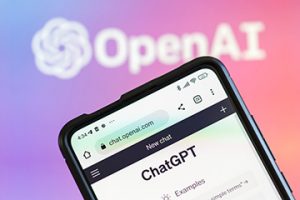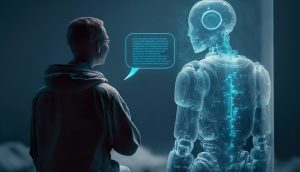Chemistry PR’s Take on the AI Revolution
The AI revolution is here. For those of us who work in public relations, journalism, and similar fields, it has the potential to be a huge disrupter. For some of us, it might even be the biggest change to our field that we’ve ever experienced! The more seasoned among us haven’t seen anything like it since the introduction of the personal computer or the dawn of the internet a decade later. Here is Chemistry PR’s take on AI…
 AI has been around for several years, but last fall’s launch of the latest version of ChatGPT has made the tool more accessible than ever. Today, more and more PR professionals, marketers, and journalists are figuring out whether or not to use AI tools like ChatGPT in their work, how to use it, and what the implications are when they do.
AI has been around for several years, but last fall’s launch of the latest version of ChatGPT has made the tool more accessible than ever. Today, more and more PR professionals, marketers, and journalists are figuring out whether or not to use AI tools like ChatGPT in their work, how to use it, and what the implications are when they do.
Here at Chemistry PR and Multimedia, we’re embracing AI as a tool that can help us do routine tasks more quickly and easily. We’ve uploaded closed captions of video we’ve produced to ChatGPT promoting it to generate descriptions for YouTube that contain keywords to help improve a video’s SEO. It also saves time brainstorming by generating lists of headlines and titles for blog posts from which we can choose the most appropriate. We have also used AI to generate images from a set of photos for the perfect headshots.
Some of our colleagues are taking these tools even further. For example, a colleague in a one-person communications department for a local nonprofit is using ChatGPT to create first drafts of everything from social media posts to media releases and even solicitation letters.
If ChatGPT and AI can do so much, where does that leave those of us who are trying to make a living in this field? As great as it is, AI can only do so much, and there are some potential pitfalls that still need a human touch to overcome.
 Dr. Mike Porter, APR, and Stephen Dupont, APR, both members of the Public Relation Society of America (PRSA) recently reminded us, ChatGPT, for example, “scrapes information from the internet to create a written response based on probability, not reason.” ChatGPT can “learn” from the humans who interact with it, but it’s essentially mining a database for answers. Without a good question, it’s hard for ChatGPT to generate a good answer.
Dr. Mike Porter, APR, and Stephen Dupont, APR, both members of the Public Relation Society of America (PRSA) recently reminded us, ChatGPT, for example, “scrapes information from the internet to create a written response based on probability, not reason.” ChatGPT can “learn” from the humans who interact with it, but it’s essentially mining a database for answers. Without a good question, it’s hard for ChatGPT to generate a good answer.
After its launch last November, it didn’t take long for humans to start catching ChatGPT’s errors. Myriads of misinformation seeping its way into and across the internet the last several years can show up in ChatGPT-generated responses. So, from an ethical standpoint, it’s wise to not rely completely on whatever ChatGPT can produce. It’s still important to have a human review and fact check the information contained in an autogenerated piece before it gets published.
The risk of putting out misinformation is just one of ChatGPT’s weaknesses. The tool has reportedly come up short when mining for information on anything more recent than around 2020 and what it does create is rudimentary. In written pieces, a human editor is still needed to address nuances and ambiguity. And a human is still better at adding some punch and personality to the writing with a well-placed quote or a clever turn of phrase.
And then there are the big questions.
The Question of Parroting. At what point will most pieces of content look and sound the same because the tool mines the same existing content in the same way?
The Question of Plagiarism. And since that existing content was generated previously by humans, at what point does the use of AI constitute plagiarism?
It’s probably too soon to answer these two questions. But it’s clear that ethical issues around AI are something our society – and potentially our governments – are going to have to address.
Many colleges and universities are expressing concerns about academic integrity and the ability for students to pass off AI-generated writing as their own work. Others are recognizing that AI will be part of their students’ future work worlds and are adapting assignments in ways that ensure any AI use is appropriate and ethical.
As PR practitioners, we will have to grapple with these issues, too. Let’s face it! Now that AI is here, it’s here to stay. And we can’t view it as a threat. Rather we must find ways to make it work for us if we are to continue successfully serving our clients and our companies.
 Chris Kuban started Chemistry PR and Multimedia with a vision to effectively formulate corporate and non-profit brands across the country. He is an expert in Media Relations, Event Management and video production. Working with a team of local and national suppliers, vendors, employees, and consultants has allowed him to coordinate more than 246 national events that help deliver the ROI his clients seek. Follow him on Twitter or connect with him on LinkedIn. Chris is proud that his firm is ranked one of the Best St. Louis Public Relations Firms in the region.
Chris Kuban started Chemistry PR and Multimedia with a vision to effectively formulate corporate and non-profit brands across the country. He is an expert in Media Relations, Event Management and video production. Working with a team of local and national suppliers, vendors, employees, and consultants has allowed him to coordinate more than 246 national events that help deliver the ROI his clients seek. Follow him on Twitter or connect with him on LinkedIn. Chris is proud that his firm is ranked one of the Best St. Louis Public Relations Firms in the region.








